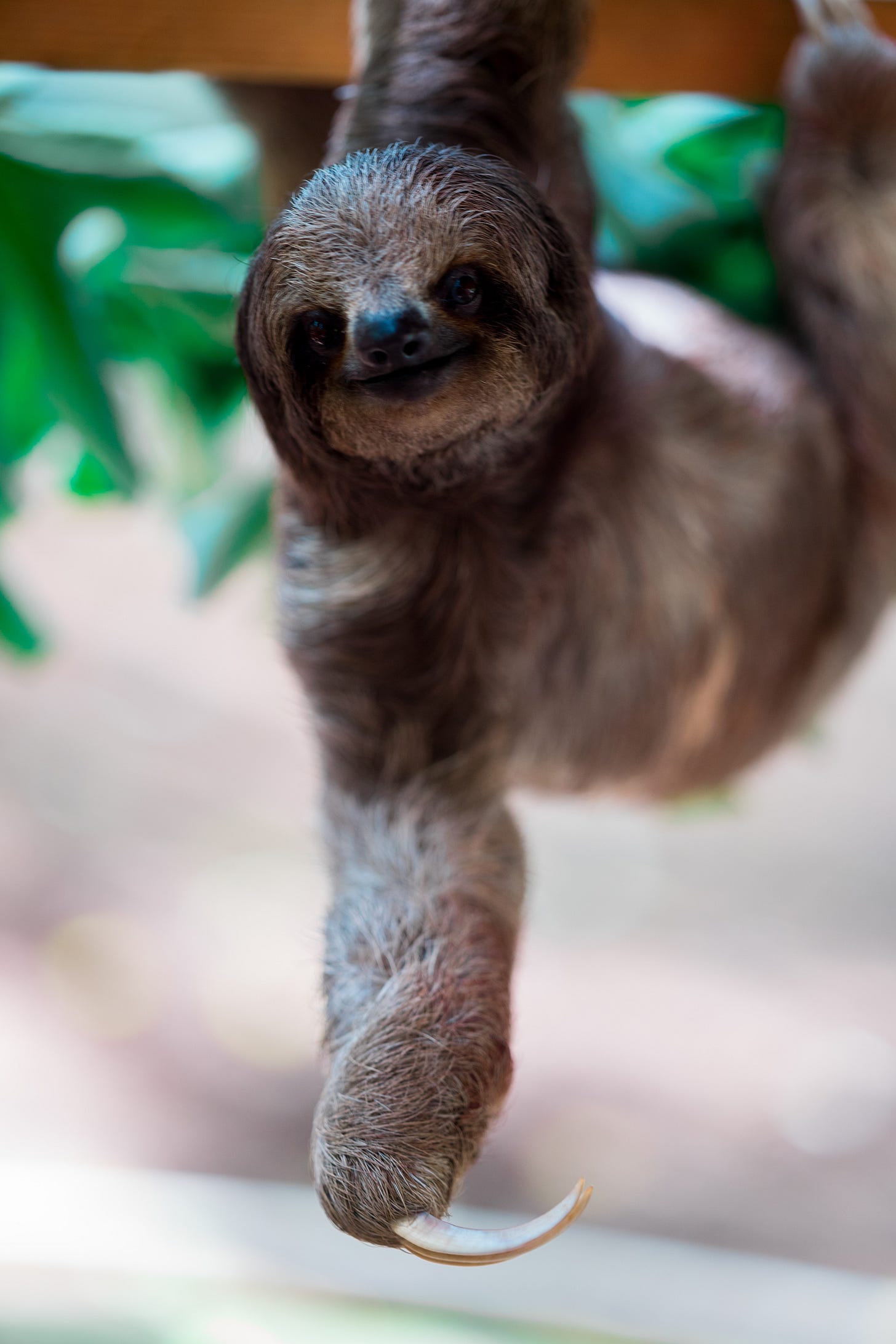Welcome to Thursday Things! If you enjoy this edition, please click the heart icon in the header or at the end of the post to let me know.
I’m a medicine sloth. It will make sense once you read today’s edition! Photo by Javier Mazzeo on Unsplash
Keep Death guessing
I like to keep an eye on anti-aging research because I am definitely anti-aging. And there are some new breakthroughs to ponder. Let’s zoom in!
Scientists Dramatically Extend Cell Lifespan in Anti-Aging Breakthrough
Scientists have achieved a significant breakthrough in the effort to slow the aging process with a novel technique that increased the lifespans of yeast cells by a whopping 82 percent, reports a new study.
Good news for the yeast, I guess. Tell me more.
By programming cells to constantly switch between two aging pathways, researchers were able to prevent them from fully committing to either deteriorative process, a method that nearly doubled the lifespan of the cells. In other words, rather than the entire cell aging at once, the aging process was toggled between different physical parts of the organism, extending its life. This synthetic “toggle switch” offers a potential roadmap toward treatments that could one day extend human longevity, though that future is highly speculative at this time.
“Not fully committing to any one deteriorative process” is my new motto.
I think I understand what they’re doing here. I once bought two pair of the same kind of shoe. By alternating which pair I wore, both sets of shoes lasted longer than if I had just bought one pair, then replaced those shoes when they wore out. At least in my mind, it was a brilliant plan. Apparently this also works at a cellular level. Good to know!
Now, a team of scientists at the University of California, San Diego (UCSD), have developed a new solution to this age-old problem that essentially tricks cells into waffling between two common deteriorative processes in cells. Using synthetic biology, the researchers genetically reprogrammed a circuit that chooses between these divergent paths toward death, causing it to constantly oscillate between its fates instead of actually dedicating itself to one.
Hmm, maybe that’s a better motto: “Constantly oscillate between your fates!”
These “oscillations increased cellular lifespan through the delay of the commitment to aging,” a result that establishes “a connection between gene network architecture and cellular longevity that could lead to rationally designed gene circuits that slow aging,” according to a study published on Thursday in Science.
Yes, let’s do that.
“The circuit resembles a toggle switch that drives the fate decision and progression toward aging and death,” said Nan Hao, a professor of molecular biology at UCSD and a senior author of the study, in an email to Motherboard.
“Once the fate of a cell is determined, then it will have accelerated damage accumulation and progression to death,” continued Hao, who also serves as co-director of UCSD’s Synthetic Biology Institute. “[I]t became obvious to us that if we could rewire this naturally-occurring toggle switch circuit to an oscillator, it will make the cell to cycle between the two pre-destined aging paths and prevent the cell from making this fate decision toward deterioration and death, and it will make the cell live longer.”
What could be more obvious? Keep oscillating between your fates!
Get all the science details at: “Genetic circuitry boosts cell longevity” SCIENCE, 27 Apr 2023, Vol 380, Issue 6643
So cute! Fanciful flying wombat by by Edward Burne-Jones. Source: Memorials of Edward Burne-Jones.
Now with wombats!
If you love wombats — and who doesn’t! — and fancy the art of the pre-Raphaelites, which you should, then this item is for you.
“O Uommibatto”How the Pre-Raphaelites Became Obsessed with the Wombat
It seems Dante Gabriel Rossetti and the rest of the pre-Raphaelite troupe were gaga for wombats. I did not know that.
Apparently, in 19th century Britain wombats were all the rage:
Wombats were admired for their stumpy strength, their patience, their placid, not to say congenial manners, and also a kind of stoic determination. Occasionally they were thought clumsy, insensible, or even stupid, but these isolated observations are out of step with the majority of nineteenth-century opinion.
“Yeah, don’t be disrespecting the wombat.” Photo by Meg Jerrard on Unsplash
In the 1860s, Rossetti often took his friends to visit the wombats at the zoo, sometimes for hours on end. On one occasion Rossetti wrote to Ford Madox Brown: "Dear Brown: Lizzie and I propose to meet Georgie and Ned [the Burne-Jones] at 2 pm tomorrow at the Zoological Gardens—place of meeting, the Wombat’s Lair."
Where else would you meet but the Wombat’s Lair? Which, incidentally, is the name of my new speakeasy.
The article goes into the general British mania for wombats and other Australian creatures, but mainly wombats, and more about Rossetti’s particular obsession with wombats. Eventually he had to get a pet wombat of his own, which he drew and wrote poems about. Because wombats!
“It’s a fine painting, but you should have kept the wombat.” Drawing by Dante Gabriel Rossetti of Jane Morris and his pet wombat, 1869. Source. Astarte Syriaca by Rossetti, 1877. Jane Morris model. Source: Wikimedia Commons
Sloths! Too slow to get sick
Most of what I know about sloths comes from an old SNL video short of dubious scientific accuracy. But apparently, these tree-dwelling fur hobos are masters of biochemistry and anti-microbial drug development. Who knew?
Costa Rican sloth antibiotics offer hope for human medicine
The fur of Costa Rican sloths appears to harbor antibiotic-producing bacteria that scientists hope may hold a solution to the growing problem of "superbugs" resistant to humanity's dwindling arsenal of drugs.
Sloth fur, research has found, hosts bustling communities of insects, algae, fungi and bacteria, among other microbes, some of which could pose disease risk.
Yet, experts say, the famously slow-moving mammals appear to be surprisingly infection-proof.
Have you ever met a sloth with a cold? I rest my case.
Chavarria and a team took fur samples from Costa Rican two- and three-toed sloths…
They found the possible existence of antibiotic-producing bacteria that "makes it possible to control the proliferation of potentially pathogenic bacteria... or inhibit other competitors" such as fungi, according to a study published in the journal Environmental Microbiology.
Basically sloths are so filthy, with so many bugs, bacteria, fungi, and God knows what else living in their fur that they have become slow-moving Petri dishes in which anti-bacteria bacteria have evolved to keep the peace.
Which is good news for us humans since we have spent the last hundred years or so stupidly overusing every known antibiotic to the point that strains of antibiotic-resistant “superbugs” are running rampant. Filthy sloth fur may hold the solution to the problem we created. So hug a sloth!
“Yeah, I can hook you up with some antibiotics.” Photo by Sophia Müller on Unsplash
Thank you for reading!
Please click the hearts, leave a comment, and use the share feature to send this issue to a friend who might enjoy it. See you next Thursday!







